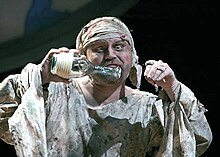
Back Amic imaginari Catalan Fantasiefreund German Amigo imaginario Spanish دوست خیالی Persian Mielikuvitusystävä Finnish Ami imaginaire French חבר דמיוני HE Երևակայական ընկեր Armenian Teman imajinasi ID Amico immaginario Italian

Imaginary friends (also known as pretend friends, invisible friends or made-up friends) are a psychological and a social phenomenon where a friendship or other interpersonal relationship takes place in the imagination rather than physical reality.
Although they may seem real to their creators, children usually understand that their imaginary friends are not real.[1]
The first studies focusing on imaginary friends are believed to have been conducted during the 1890s.[2] There is little research about the concept of imaginary friends in children's imaginations. Klausen and Passman (2007) report that imaginary companions were originally described as being supernatural creatures and spirits that were thought to connect people with their past lives.[3] Adults in history have had entities such as household gods, guardian angels, and muses that functioned as imaginary companions to provide comfort, guidance and inspiration for creative work.[3] It is possible the phenomenon appeared among children in the mid-19th century when childhood was emphasized as an important time for play and imagination.[3]
- ^ Taylor, M. (1999) Imaginary Companions and the Children Who Create Them. New York: Oxford University Press.
- ^ Klausen, Espen; Richard H. Passman (December 2006). "Pretend companions (imaginary playmates): the emergence of a field". Journal of Genetic Psychology. 167 (4): 349–364. doi:10.3200/gntp.167.4.349-364. PMID 17645227. S2CID 35306762. Gale Document Number: GALE|A166239640. Retrieved 9 November 2011.
- ^ a b c Klausen, E.; Passman, R. H. (2007). "Pretend companions (imaginary playmates): The emergence of a field". The Journal of Genetic Psychology. 167 (4): 349–364. doi:10.3200/gntp.167.4.349-364. PMID 17645227. S2CID 35306762.
© MMXXIII Rich X Search. We shall prevail. All rights reserved. Rich X Search